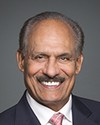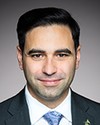Thank you. It's a good question.
On the way we choose our countries, basically we're looking for countries where access to finance is low. We're a small investor on the global scale in microfinance. There are some very large funds investing these days. We're looking for countries where access to finance is low. There's an excellent database, created by the World Bank, called Findex. They surveyed one thousand in every country and made this database where you can see the percentage of access to credit and to formal accounts. It's very detailed. It goes according to women, men, regions, and all kinds of financial products.
We use this database first of all to target specific countries where the need is higher, although maybe not the highest. For example, I mentioned Tajikistan, where 5% of people have access to a formal savings account. We believe the need is high. This is a social impact opportunity but also a business opportunity. If 95% of people don't have access to finance, surely some of them would need some access. In Canada, access to a formal savings account, just to give a comparison, is 97%. That gives you an idea of what percentage of people would like to have access.
On the question of poverty reduction, of course when microfinance started out, especially in the 1990s or early 2000s, there was a lot of focus on microfinancing for reducing poverty. This leads to very strong demand, then, to prove it, but everyone needs financial services. We all use financial services. We need loans to finance our homes. We need loans to go to school. It's very difficult to prove that the fact that I have access here to financial services helps me get out of poverty. It's been equally difficult to prove this as the determining factor that helps people get out of poverty. Countries may be developing. Some people are more entrepreneurial than others.
The truth is that financial services can also be harmful, because if you get into too much debt, if you get different loans from different institutions, that could lead to over-indebtedness. We even heard about suicides in India. Then people can turn around and say, “How could you say that this led to poverty reduction? It led to suicides.” I think it's quite risky to say that financial services lead to poverty reduction. They lead to economic development. That we know for sure. We shouldn't have to prove, time and again, that financial services are useful to people.
That's just one example. I don't think the focus should be on proving, every time you did an action, that it led to poverty reduction, because there are too many factors involved in poverty. As you mentioned before, poverty is very complex. It's not just GDP. It's not just access to education or health. We believe we have to put in place the factors to ensure that poverty reduction will occur, but we shouldn't have to prove it every time.




